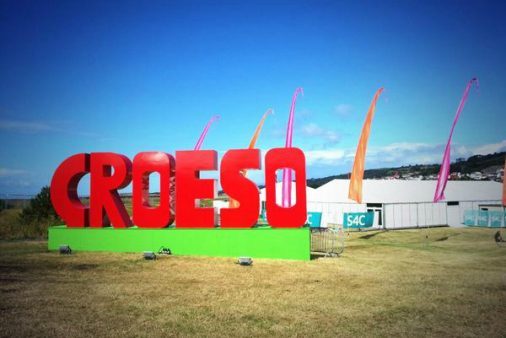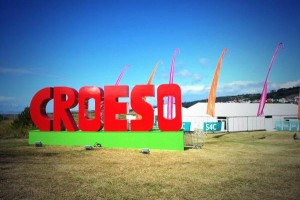Celebrating Welsh culture
29 October 2015
From Cardiff’s Tafwyl festival to the much-loved Eisteddfod, Joanna Davies outlines why more and more people are flocking to these annual celebrations.

For a new arrival in Cardiff the lure of the Tafwyl proved overwhelming this year. “I heard music coming from the Castle and was intrigued,” he told me. “I followed it through the Castle gates into what seemed to me like another world. It was wonderful to be surrounded by the Welsh language and culture, to see its richness and variety.”
“Too much to list, more than you can wish for” – the words of Tafwyl ambassador Matthew Rhys echo this sentiment. Tafwyl is many things to many people, with events as diverse as circus skills workshops, to a band that fuses New Orleans jazz and Welsh trad. Tafwyl embraces both the traditional and more modern elements of Welsh culture, making it a far cry from a troop of women dressed in traditional Welsh ladies’ costumes, playing harps and selling Welsh cakes.
In July of this year Cardiffians celebrated the 10th Tafwyl The festival was established in 2006 by organisers Menter Caerdydd, following the demand from residents for a festival to raise the profile of the Welsh language in the capital city. Since its beginnings in the Mochyn Du pub in Pontcanna, the festival has mushroomed into a week-long event of activities across Cardiff, culminating in a Welsh fair in Cardiff Castle grounds on the final festival weekend. The annual turn-out for Tafwyl has increased year on year, peaking at over 34,000 visitors in 2015.
Cardiff University has been a strong supporter of the Festival since its inception with staff and students taking part annually in the programme. The University has also recently become a lead sponsor for the event.
Something for everyone
At 2013’s Tafwyl, the University’s School of Journalism, Media and Cultural Studies launched digital news and networking service Pobl Caerdydd (Cardiff People), in response to a need for Welsh language content. It’s a thriving service that appeals to a young and digitally literate audience in Cardiff.
For this year’s Tafwyl, Pobol Caerdydd collaborated with Made in Cardiff, a new Cardiff-centric digital TV channel and Cardiff University’s Welsh for Adults Centre. Made in Cardiff journalist Ndidi Spencer has been learning Welsh with the help of the Centre tutor and Cardiff alumnus, Glyn Wise. Ndidi practised her Welsh language skills under Glyn’s watchful eye, interviewing Tafwyl visitors for Made in Cardiff’s programme, What’s Occurin’ Cardiff?
Glyn has been working as a Welsh tutor at the Welsh for Adults Centre for a year and is a big Tafwyl fan. This year, he worked in the festival’s Welsh Learners’ Café which, he feels, is “a great place for people to get together to pick up some conversational Welsh”. He said:
“Tafwyl is a unique festival in Cardiff as it shows the Welsh language is an important part of the city, and helps people realise that you can live your life every day through the medium of Welsh.”
Also present at the festival was School of Welsh academic Dr Dylan Foster Evans who spoke about the history of Cardiff Castle. His talk included the story of the original ‘Clwb Ifor Bach’ (Welsh Club) – ‘The Glove and Shears’ – a hangout for 19th century poets; the Welsh Club was named after Ifor Bach, the 12th century Welsh lord of Senghennydd. Legend has it that Ifor kidnapped the Earl of Gloucester and his family in the 12th century, keeping them captive in Senghennydd Woods over a land dispute with the oppressive nobleman.
Eisteddfod and beyond
The other major Welsh language festival for lovers of the pethe (Welsh culture) is the National Eisteddfod. This year’s Eisteddfod was in Meifod, mid Wales, and Cardiff University’s stand offered a range of eclectic events – from a discussion on the future of Welsh media to the challenges involved in translating the classic children’s story, Alice in Wonderland.
One of the University’s resident experts on Welsh dialects, Dr Iwan Rees, collected examples of various dialects from visitors from across Wales as part of his research. Dr Rees is particularly intrigued with the unique Meifod dialect, where cath (cat) is always cieth. He said: “It’s interesting how the region links Welsh in the north and Welsh in the south. Where the gogs’ use of ‘iau’ and the southies’ use of ‘afu’ for ‘liver’, gives us the mid Walian ‘iafu’. Believe it or not, the last attempt to map Welsh dialects was in 1973 with the publication of the Linguistic Geography of Wales. This study will give us a long overdue analysis of the linguistic changes in modern Wales over the past four decades and will also reveal the richness of our dialects.”
The School of Welsh recently introduced its ‘Welsh for All’ scheme, which is giving Cardiff University students the opportunity to learn Welsh in the academic year 2015/16.
Students were also busy on the Eisteddfod field working on Llais y Maes (Voice from the Field), the first digital newspaper from the University’s Centre for Community Journalism. In partnership with the Eisteddfod, www.llaisymaes.com is a bilingual website run by an editorial team of seven Cardiff University students which includes non-Welsh speakers.
Working on the website has provided Cardiff students with valuable on-the-groundwork experience. Lorena Riverio, a Master’s student in international journalism who worked on Llais y Maes last year, said: “I’m from Spain and have always been interested in other cultures and languages. That’s why being part of the Llais y Maes project was such an exciting opportunity for me.”
For others, the Eisteddfod has an emotional meaning, as Morgan Towler, a journalism student from Llandeilo, explains: “When I heard about the opportunity to take part in work experience at the National Eisteddfod, I jumped at the chance. I’ve taken part in the Eisteddfod every year in school and so I felt that it was about time that I gave something back to the cultural festival which gave me some of my favourite childhood memories.”
Cardiff University & the Welsh language
- Cardiff University attracts the largest number of Welsh speaking students in Wales.
- The University offer 170 Welsh language modules that students can study in a variety of subjects – from genetics to Greek philosophy.
- The School of Welsh is one of the oldest departments of Welsh in Wales, and Cardiff University hosts the oldest established Chair of Welsh.
- 25 prospective Cardiff University students won Incentive Scholarships of between £1,500 and £3,000 from the Coleg Cymraeg Cenedlaethol this year. Throughout the 2015/16 academic year, they will study a range of subjects through the Welsh medium, including, for the first time, Medicine.
- Cardiff students can study up to a third of their degrees in Medicine and Healthcare sciences through the medium of Welsh. The university provides the NHS in Wales with a Welsh speaking workforce which means patients can speak to practitioners in their mother tongue.
Welsh and the City
- Since the late 1990s, the number of Welsh speakers in Cardiff has more than doubled; from 18,000 speakers in 1999 to 36,735 speakers in 2011, according to the most recent Welsh census
- The first National Eisteddfod was held in Cardiff in 1883
- The festival last visited the capital in 2008, where it attracted a record 160,000 visitors
- At Cardiff Eisteddfod in 1939 a petition was launched by Undeb Cymdeithasau Cymru (The Union of Welsh Societies), calling for recognition of the Welsh language in the courts. Their presentation of the petition to Parliament in 1941 lead to the passing of the Welsh Courts Act of 1942 and the validation of pleas in the Welsh language.
- Cardiff Council has recently approved plans to open a Welsh language and cultural centre in the Old Library in Cardiff. Among the activities planned for the centre are Welsh language courses run by Cardiff University and music events for Welsh bands, hosted by nightclub, Clwb Ifor Bach.
- July 2024
- June 2024
- May 2024
- April 2024
- March 2024
- February 2024
- January 2024
- December 2023
- November 2023
- October 2023
- September 2023
- August 2023
- July 2023
- June 2023
- May 2023
- April 2023
- March 2023
- February 2023
- January 2023
- November 2022
- October 2022
- September 2022
- August 2022
- July 2022
- June 2022
- May 2022
- April 2022
- March 2022
- February 2022
- January 2022
- December 2021
- November 2021
- October 2021
- September 2021
- August 2021
- July 2021
- June 2021
- May 2021
- April 2021
- March 2021
- February 2021
- January 2021
- December 2020
- November 2020
- October 2020
- September 2020
- August 2020
- July 2020
- June 2020
- May 2020
- April 2020
- March 2020
- January 2020
- December 2019
- November 2019
- October 2019
- September 2019
- August 2019
- July 2019
- May 2019
- April 2019
- March 2019
- February 2019
- January 2019
- December 2018
- November 2018
- October 2018
- September 2018
- August 2018
- July 2018
- June 2018
- May 2018
- April 2018
- March 2018
- February 2018
- December 2017
- November 2017
- October 2017
- September 2017
- August 2017
- July 2017
- June 2017
- May 2017
- April 2017
- March 2017
- February 2017
- January 2017
- November 2016
- October 2016
- September 2016
- July 2016
- June 2016
- May 2016
- April 2016
- March 2016
- February 2016
- January 2016
- December 2015
- November 2015
- October 2015
- September 2015
- August 2015
- January 2015
- December 2014
- November 2014
- September 2014
- August 2014
- May 2014